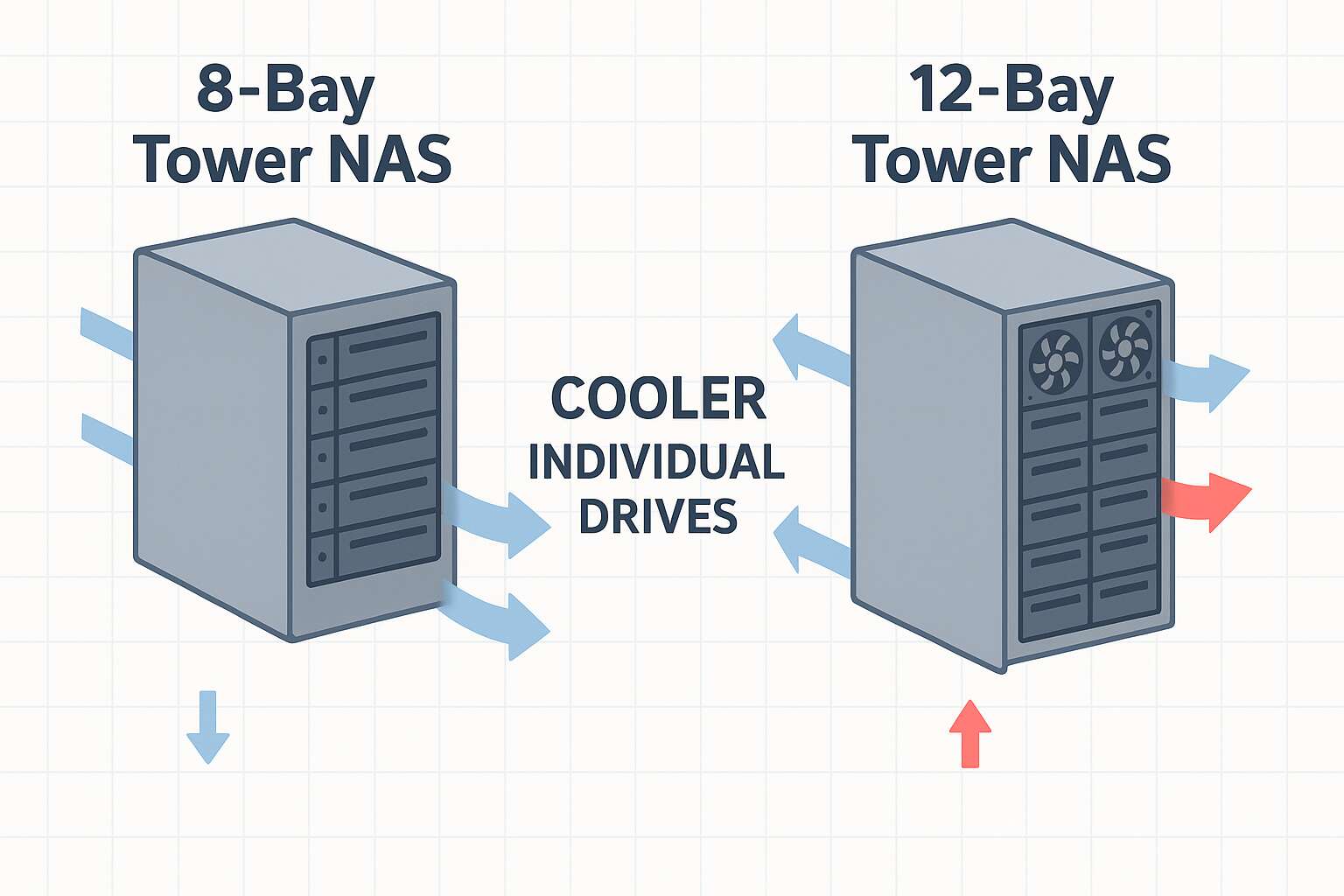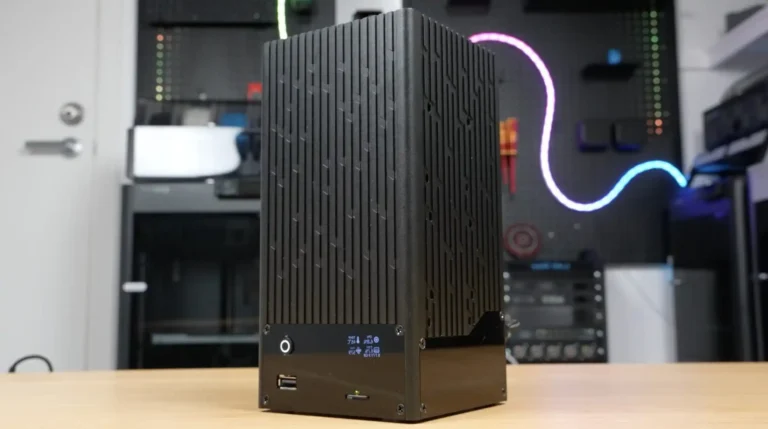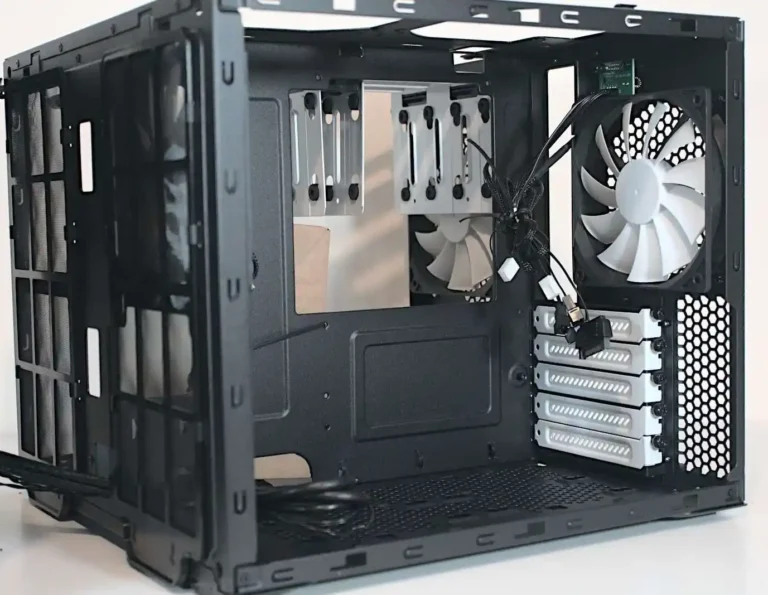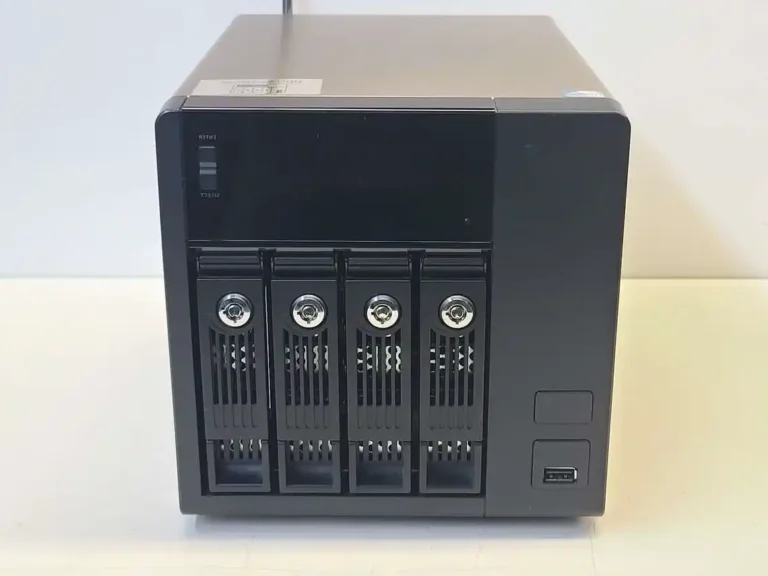You’re picking between an 8-bay and a 12-bay NAS. On paper it’s “four more bays.” In a rack or on your desk, it’s airflow, noise, drive temps, and how fast you can service a failed disk. Let’s walk it, real-world style—short, punchy, and useful.
NAS cooling basics: airflow, static pressure, fan size
Drives shed heat non-stop. Cooling works when air goes front-to-back through the drive stack, not around it. Tower boxes usually lean on dual 120 mm fans: big blades, slower spin, quieter tone. Rackmount 2U gear often uses smaller, faster fans to push static pressure through dense cages. More bays tighten the path; any leak or dust slows the flow and temps creep. Simple truth: denser bays demand tighter seals and better pressure.
8-bay NAS vs 12-bay NAS cooling and density
An 8-bay tower often stays quiet on low RPMs. A 12-bay tower with the same fan layout has to work harder to keep per-drive airflow similar, so it tends to ramp up sooner during parity checks, rebuilds, or big scrubs. A 12-bay in 2U flips the script: strong pressure, great front-to-back airflow, but the acoustic profile jumps. Choose your pain: noise budget or space budget.
Rackmount vs tower: server rack pc case considerations
Going rack? You care about front filtration, blanking panels, and rails. A proper server rack pc case lets you seal the intake, guide air through the cages, and slide the chassis for quick swaps—no wrestling. In a living room closet or studio, a tower NAS with big fans usually wins on tone and comfort. Different habitats, different winners.
Table: quick compare of cooling trade-offs
| Form factor | Bays | Typical system fans | Airflow path | Noise profile | Serviceability | Best for |
|---|---|---|---|---|---|---|
| Tower | 8 | Dual 120 mm | Good with minimal sealing | Quiet at idle/load | Side-open, basic screws | Home lab, quiet office, branch share |
| Tower | 12 | Dual 120 mm | Needs better sealing & fillers | Louder during rebuilds | Similar to 8-bay | Media teams, SMBs needing extra slots |
| 2U Rack | 12 | Multiple small high-RPM | Strong pressure through cages | Noticeably louder | Rails, hot-swap convenience | Data closets, MDR/MSP racks, staging |
Note: “Quiet/loud” depends on fan curves, filters, room size, and ambient heat. Your mileage will vary, a bit.
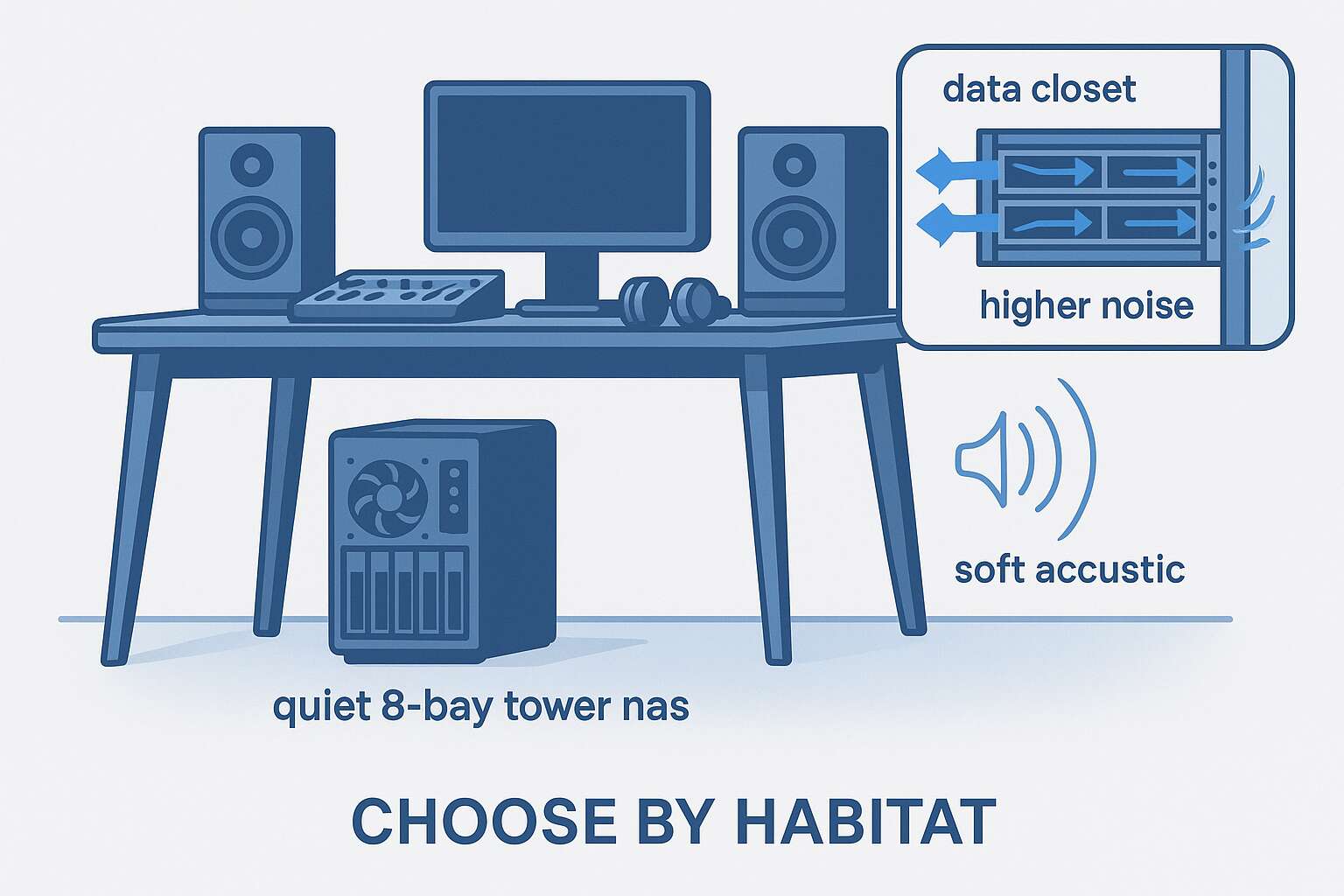
Scenarios: pick by job, not by dream
Home lab / creator studio (tower NAS cooling)
You don’t want a wind tunnel. An 8-bay tower with 120 mm exhausts keeps a low whoosh and stable temps if you keep the filters clean. If you might grow to 12 later, start with a chassis that has proper slot fillers ready. Take a look at NAS Devices and ITX Case if you like compact builds with straight airflow paths.
Branch office / SMB share (server pc case)
For a small team file server, an 8-bay meets most shares, backups, and VM disks just fine. You’ll like the calmer acoustics and less fan ramp under mixed load. If you know growth is coming, a 12-bay tower still works—just plan for blanking, cable discipline, and dust control. When you need a general server pc case with room for storage plus NICs/HBAs, go that route.
Data closet / MSP rack (computer case server)
A rack wins when you care about density and MTTR. Slide rails, labeled trays, front-accessible filters—done. A computer case server in 2U or 3U with decent intake filtration keeps pressure up and maintenance fast. It’s louder, yeah, but a closet doesn’t mind.
AI datasets / media ingest (GPU adjacent)
If you park big datasets near compute, storage and GPUs live side by side. Use a roomy rackmount with strong intake and straight ducts so disks don’t bake behind hot accelerators. Pair storage chassis with GPU Server Case for clean airflow lanes between drives and cards. Keep intakes sealed; don’t let hot exhaust loop back to the front.
Key arguments and data-backed notes (plain English)
Tower NAS 120 mm fans: 8-bay vs 12-bay per-drive airflow
Same fan spec, more bays. That means tighter airflow per drive on the 12-bay unless you raise RPMs or tidy the pressure path. Use slot fillers, close bezel gaps, and keep cables out of the intake lane.
2U rackmount 12-bay: static pressure and noise profile
Small fans at higher RPM punch through dense cages. You get great cooling under rebuild stress, but the tone is sharper. In a rack room, it’s fine; in a living room, not so much.
Temperature vs reliability: stay in the comfort band
Disks tolerate a range. The risk rises when you run near the top of that range for long stretches or create hot spots. Focus on stable temps, not chasing the absolute lowest number. Smooth curves beat spiky ones.
Blanking panels, filters, and pressure drop
Empty bays become leaks. Without fillers, air shortcuts around drives, not through them. Dust filters and tight mesh add resistance; clean them regular or step up fan pressure a notch. Don’t over-mesh the intake unless you love fan ramp.
Bigger fans vs smaller fans: the power/noise trade
Large fans move the same air at lower RPM. Smaller fans need speed to match, which adds hiss. If you want quiet, choose chassis that accept bigger spinners, or a taller rack unit with calmer airflow.
Noise in home spaces: keep the tone friendly
Low-frequency whoosh beats high-pitch whine. Towers with 120 mm exhausts usually keep the whoosh. Stick the box on solid ground, avoid hollow cabinets, and let the rear breathe. A little placement hack goes far.
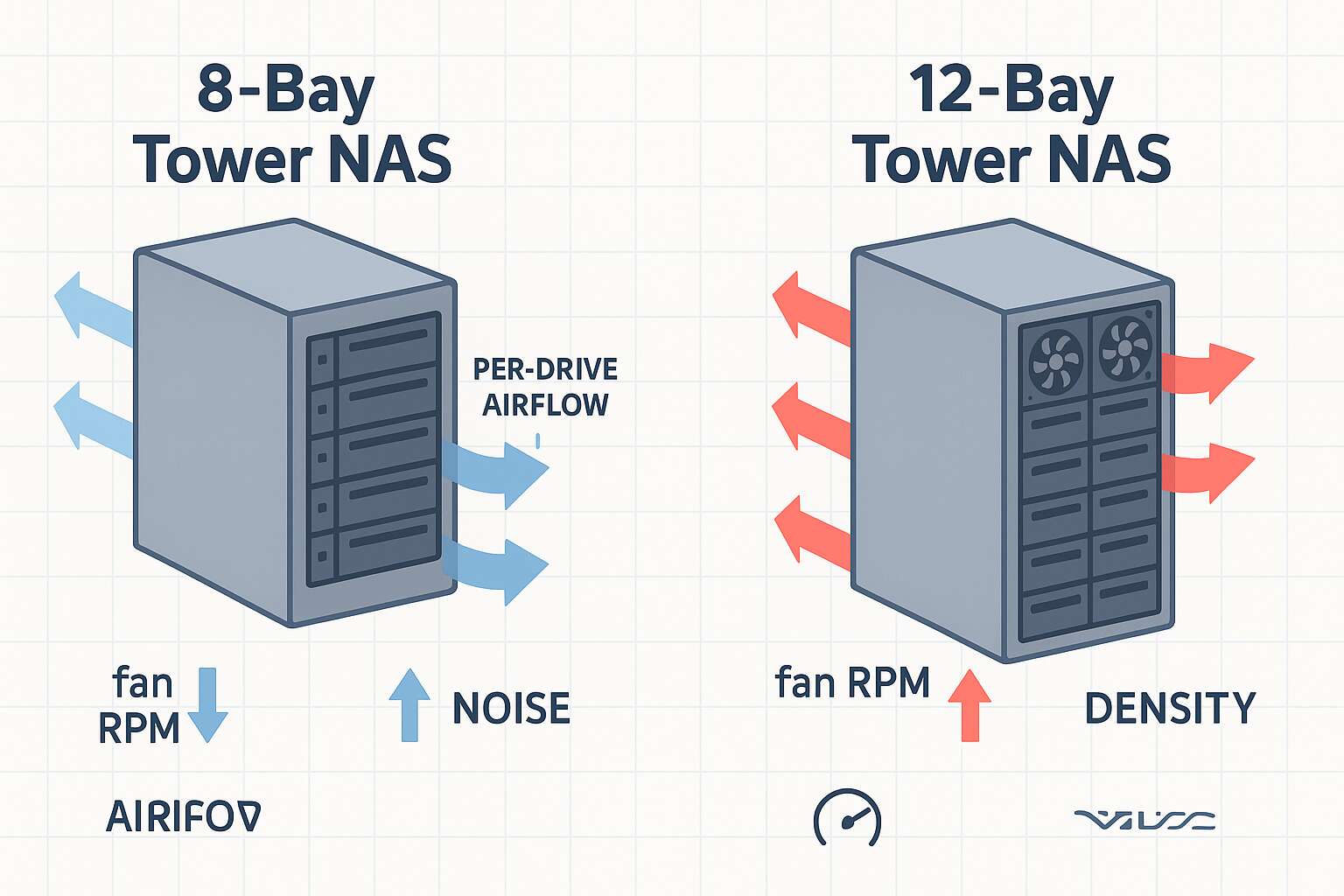
Practical tuning checklist (copy-paste to your build doc)
- Seal the path: install blanking trays in unused bays.
- Keep dust honest: clean front filters; don’t stack them.
- Front-to-back only: no side leaks, no off-axis fan mods.
- Cable map: route SAS/SATA neatly; don’t drape across intake.
- Fan curves: set a calm base RPM, step up smoothly under rebuild.
- Drive layout: spread hot spindles; check for local hot spots.
- Rails: plan for pulls. Chassis Guide Rail shortens downtime, saves fingers.
ATX builds: atx server case tips
If you’re building a hybrid storage box around ATX, pick an atx server case with straight intake and a clear duct from front bays to rear fans. Avoid decorative vents that bleed pressure. If you must add a front fan wall, match it with a tidy dust filter and a solid bezel seal.
Why IStoneCase shows up in these picks (OEM/ODM, bulk-friendly)
IStoneCase focuses on GPU/Server Case and Storage Chassis with OEM/ODM options. That means you can ask for custom fan walls, pre-installed filters, specific rail kits, or bay counts tuned to your stack. Bulk buys for data centers, research labs, MSPs, and builders are normal. You bring the workload, we co-design the chassis to fit: airflow targets, acoustic goals, service style. Start at the hub and jump by need: IStoneCase Home, then Rackmount Case, Server Case, NAS Devices, Wallmount Case.

